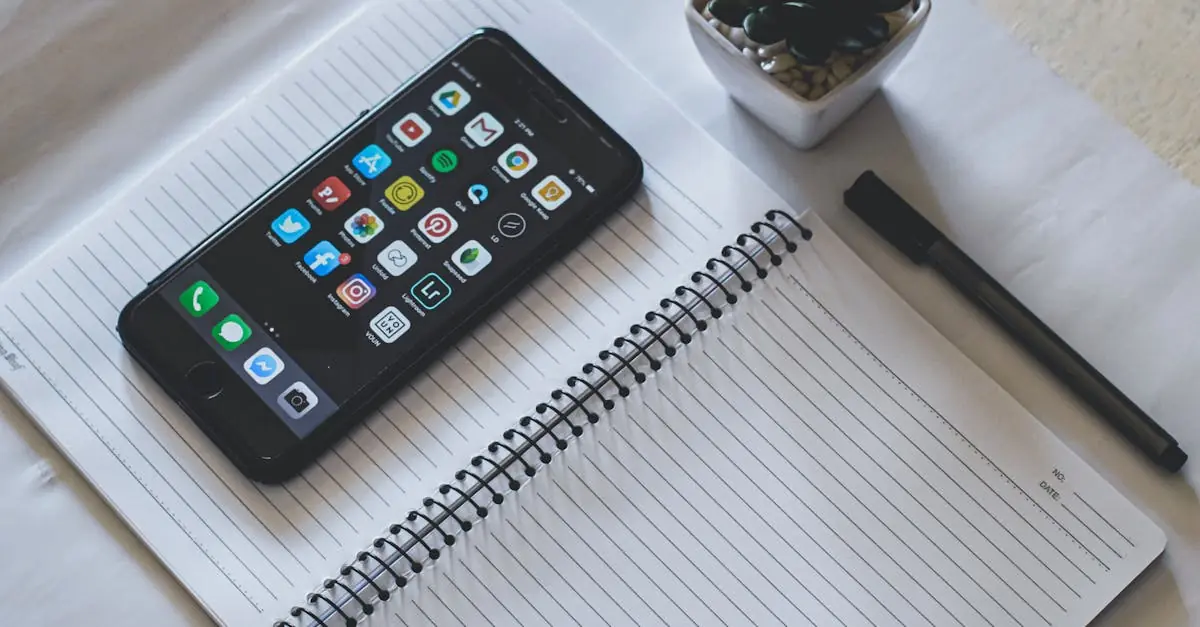Table of Contents
ToggleEver scrolled through your iPhone and wondered where your favorite apps went? It’s like they’ve pulled a magic trick and vanished into thin air. Don’t worry; you’re not losing your mind or entering an alternate dimension. This common conundrum can leave anyone scratching their head, and it’s more common than you think.
Understanding App Visibility on iPhone
Many iPhone users face issues with app visibility. Certain features and settings can hide apps, leading to confusion.
Common Reasons for Invisible Apps
Certain reasons explain why apps may not appear. Apps could accidentally be deleted from the home screen. Another possibility involves moving them to the App Library, leaving users unable to find them easily. Users often enable restrictions that prevent certain apps from showing as well. Accidental organization during updates may also hide apps unknowingly.
iOS Features That Affect Visibility
iOS includes features that influence app visibility. The “Hide Home Screen” option allows users to remove entire pages of apps from sight. Additionally, the “Screen Time” feature enables users to limit access to specific apps based on usage. The “Offload Unused Apps” setting may also cause apps to disappear temporarily while keeping their data intact. Understanding these features helps users locate their apps efficiently.
Troubleshooting Steps
If apps are invisible on an iPhone, follow these troubleshooting steps to resolve visibility issues efficiently.
Check for Hidden Home Screen Pages
Look at the right side of your iPhone home screen. Sometimes, users unknowingly hide entire pages of apps. To check if this is the case, long-press on any blank area on the home screen. Enter the “Edit Home Screen” mode by tapping the dots at the bottom of the display. Each page shows a checkmark if visible. Uncheck any boxes next to hidden pages, then tap “Done.” Users often find their missing apps located on these previously hidden pages.
Resetting Home Screen Layout
Consider resetting the home screen layout if apps remain elusive. This option returns all app icons to the original layout, making it easier to find misplaced apps. Navigate to Settings, then General, and tap on Transfer or Reset iPhone. From there, select Reset, then choose Reset Home Screen Layout. Confirm your selection to restore the default layout. Following this process can make locating apps simpler and less frustrating.
Potential Software Issues
Software issues can cause apps to become invisible on an iPhone. Identifying the specific problem can help users restore app visibility effectively.
Glitches After an Update
Glitches often arise following software updates. Users might notice that some apps disappear unexpectedly after installing a new iOS version. In these instances, rebooting the device can sometimes resolve the issue. Updating apps also helps, as app developers frequently release updates to ensure compatibility with the latest iOS. Moreover, hard resetting the device might fix lingering bugs, allowing apps to reappear. If glitches continue, checking Apple’s support page for known issues can provide further guidance.
App Compatibility Problems
App compatibility problems occur when apps do not align with the current iOS version. Apps designed for earlier iOS versions may exhibit visibility issues or fail to launch. Ensuring all apps are updated to their latest versions reduces the likelihood of compatibility issues. Users can also check the App Store for compatibility information before downloading. In some cases, older apps simply need to be removed and reinstalled to restore functionality. Restarting the iPhone after reinstalling can also enhance performance and app visibility.
User Settings and Restrictions
User settings can significantly impact app visibility on iPhones. Two main types of restrictions often contribute to this issue: Screen Time restrictions and Content and Privacy restrictions.
Screen Time Restrictions
Screen Time restrictions allow users to manage app usage effectively. If they set limits on specific apps, those apps might not appear on the home screen when the limit is reached. Users can check this by navigating to Settings, selecting Screen Time, and reviewing app limits. By adjusting or removing these limits, visibility of affected apps can be restored. Furthermore, users can disable the option to hide apps from their home screen for a clearer view of all applications.
Content and Privacy Restrictions
Content and Privacy restrictions offer another layer of control over app visibility. Enabling these restrictions may prevent certain apps from displaying or functioning as expected. Users can access these settings under Screen Time, then select Content & Privacy Restrictions. From there, adjusting settings for app access can resolve visibility concerns. Disabling restrictions on specific apps allows them to show up again, enhancing app accessibility for the user. Regularly reviewing these settings ensures no unintended limitations apply to frequently used apps.
Finding invisible apps on an iPhone can be frustrating but it’s a common issue with straightforward solutions. By understanding the factors that lead to app visibility problems users can regain access to their favorite applications. Whether it’s adjusting settings or utilizing troubleshooting steps the path to visibility is manageable. Regularly checking app restrictions and ensuring updates are current can prevent future occurrences. With a little patience and the right approach users can keep their app library organized and accessible.





